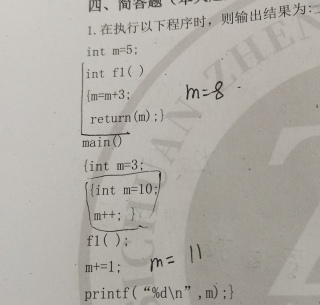关于#c语言#的问题:这个代码块里面放f1函数是不是相当于没有改变m的值呢

这个代码块里面放f1函数是不是相当于没有改变m的值呢,我感觉允许出来是十一呢。能下解题步骤吗为什么是四
因为m是一个全局变量,括号里面的m是局部变量,局部变量的范围在括号内。现在在main函数里,因此main函数的m=3有效,+1是main函数这个生效!main里面的大括号出了大括号这里面的值就无效了!
不知道你这个问题是否已经解决, 如果还没有解决的话:- 你可以看下这个问题的回答https://ask.csdn.net/questions/154575
- 这篇博客也不错, 你可以看下钢条切割问题,如果每次切割还要付出固定成本c和输出切割方案,解决思路和示例代码
- 除此之外, 这篇博客: 【算法分析与设计】经典排序算法实现中的 完整代码 部分也许能够解决你的问题, 你可以仔细阅读以下内容或者直接跳转源博客中阅读:
public class Sort implements SortInterface { //定义待排序序列 private int[] record; //定义待排序序列长度 private int length; public Sort(int[] record, int n) { this.record = record; this.length = n; } @Override public void insertSort() { int temp, position; //排序进行length-1趟 for (int i = 1; i < length; i++) { //暂存待插记录 temp = record[i]; //寻找插入位置 for (position = i; position > 0 && temp < record[position-1] ; position--) { //符合循环条件的依次右移一位 record[position] = record[position-1]; } //插入元素 record[position] = temp; } } @Override public void shellSort() { int temp, position; //增量为d时直接插入排序 for (int d = length/2; d >= 1; d /= 2) { for (int i = d; i < length; i++) { //暂存待插记录 temp = record[i]; for (position = i; position - d >= 0 && temp < record[position-d]; position-= d) { //记录后移d位 record[position] = record[position-d]; } record[position] = temp; } } } @Override public void bubbleSort() { //第一趟冒泡排序的区间是r[0]~r[length-1] int exchange = length - 1; int position, bound, temp; //当上一趟排序有记录交换的时候 while (exchange != 0) { bound = exchange; exchange = 0; for (position = 0; position < bound; position++) { if (record[position] > record[position+1]) { temp = record[position]; record[position] = record[position+1]; record[position+1] = temp; //记载每一次记录交换的位置 exchange = position; } } } } //一次划分的算法 private int partition(int first, int last) { //初始化一次划分区间 int i = first, j = last, temp; while (i < j) { //右侧扫描 while (i < j && record[i] <= record[j]) { j--; } //将较小记录交换到前面 if (i < j) { temp = record[i]; record[i] = record[j]; record[j] = temp; i++; } //左侧扫描 while (i < j && record[i] <= record[j]) { i++; } //将较大记录交换到后面 if (i < j) { temp = record[i]; record[i] = record[j]; record[j] = temp; j--; } } //i为轴值记录的最终位置 return i; } @Override public void quickSort(int first, int end) { if (first >= end) { return; } else { //一次划分 int pivot = partition(first, end); //对左侧子序列快速排序 quickSort(first, pivot-1); //对右侧子序列快速排序 quickSort(pivot+1, end); } } @Override public void selectSort() { int index, temp; //n-1趟的简单排序 for (int i = 0; i < length; i++) { index = i; //在无序区查找最小记录,并置于新有序区最后一位 for (int scan = i+1; scan < length; scan++) { if (record[scan] < record[index]) { index = scan; } } if (index != 1) { temp = record[i]; record[i] = record[index]; record[index] = temp; } } } //左右子树都是大根堆,实现指定节点调整 private void sift(int key, int last) { //暂存变量 int temp; //siftNode为待调整结点 int siftNode = key; //max初始化为siftNode的左孩子 int max = 2 * siftNode + 1; while (max <= last) { //选取左右孩子较大者 if (max < last && record[max] < record[max+1]) { max++; } //已经是堆 if (record[siftNode] > record[max]) { break; } else { //待调整结点与max互换 temp = record[siftNode]; record[siftNode] = record[max]; record[max] = temp; //siftNode、max重新赋值,准备下一趟调整 siftNode = max; max = 2 * siftNode + 1; } } } @Override public void heapSort() { int temp = 0; //从最后一个分支节点至根结点 for (int index = length/2-1; index >= 0; index--) { sift(index, length-1); } for (int i = 1; i < length; i++) { //暂存最大元素 temp = record[0]; //最右叶子放到根结点 record[0] = record[length-i]; record[length-i] = temp; //对 r[0]~r[length-i-1]建堆 sift(0, length-i-1); } } private void merge(int first1, int last1, int last2) { //定义辅助数组temp int [] temp = new int[length]; //设置两个待合并的起止区间 int i = first1, j = last1 + 1, index = first1; //依次取两序列中小者放入temp while (i <= last1 && j <= last2) { if (record[i] <= record[j]) { temp[index++] = record[i++]; } else { temp[index++] = record[j++]; } } //对第一个子序列进行收尾处理 while (i <= last1) { temp[index++] = record[i++]; } //对第二个子序列进行收尾处理 while (j <= last2) { temp[index++] = record[j++]; } //将合并后的结果传回数组record for (index = first1; index <= last2; index++) { record[index] = temp[index]; } } @Override public void mergeSort1(int first, int last) { //待排序的序列只有一条记录,递归结束 if (first == last) { return; } else { int mid = (first + last)/2; //归并排序前半个序列 mergeSort1(first, mid); //归并排序后半个序列 mergeSort1(mid+1, last); //将已排序的两个序列合并 merge(first, mid, last); } } private void mergePass(int h) { int i = 0; //有两个长度为h的子序列 while (i <= length - 2*h + 1) { merge(i, i+h-1, i+2*h-1); i += 2*h; } //子序列有一个长度小于h if (i < length - h + 1) { merge(i, i+h-1, length-1); } } @Override public void mergeSort2() { //初始时子序列长度为1 int h = 1; while (h < length) { //一趟排序 mergePass(h); h*=2; } } @Override public void print() { for (int i : record) { System.out.print(i + " "); } } }最后是一个简单的测试类
import java.util.Scanner; public class SortTester { public static void main(String[] args) { // TODO Auto-generated method stub int[] record = {2, 5, 1, 7, 9, 4, 3, 6, 5, 8}; SortInterface sort = new Sort(record, record.length); System.out.print("1.直接插入排序\n" + "2.希尔排序\n" + "3.冒泡排序\n" + "4.快速排序\n" + "5.简单选择排序\n" + "6.堆排序\n" + "7.二路归并递归排序\n" + "8.二路归并非递归排序\n" + "请选择使用的排序技术编号>"); Scanner scanner = new Scanner(System.in); int select = scanner.nextInt(); switch (select) { case 1 : sort.insertSort(); break; case 2: sort.shellSort(); break; case 3: sort.bubbleSort(); break; case 4: sort.quickSort(0, record.length-1); break; case 5: sort.selectSort(); break; case 6: sort.heapSort(); break; case 7: sort.mergeSort1(0, record.length-1); break; case 8: sort.mergeSort2(); break; default : System.out.println("输入错误!"); } sort.print(); scanner.close(); } }
如果你已经解决了该问题, 非常希望你能够分享一下解决方案, 写成博客, 将相关链接放在评论区, 以帮助更多的人 ^-^